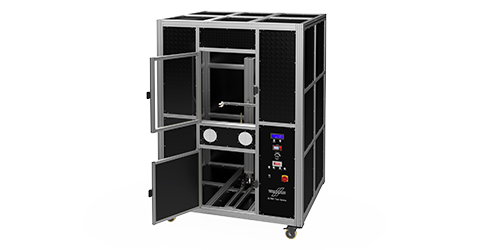UL 2596
UL 2596 Standard

Wazau UL 2596 Test Chamber
1. Scope and Application
- UL 2596 specifies test methods for evaluating the thermal and mechanical performance of battery enclosure materials used in electric vehicles (EVs), in order to assess their resistance to lithium-ion battery thermal runaway.
- The test scope reflects typical thermal and mechanical impacts from a thermal runaway event, such as high temperature, high pressure, ejected materials, and mechanical impact.
2. Purpose of the Tests
- UL 2596 does not require exact end-use performance response; instead, it provides a basis for comparing the characteristics of different materials under standardized conditions, supporting the selection of suitable materials and evaluating performance variability during development.
3. Main Test Methods
a) Torch and Grit (TaG) Test
- The material sample (commonly a flat sheet) is exposed to a high-temperature flame combined with abrasive particle impact (“grit blast”), simulating the thermal and erosive effects of hot ejecta released during battery thermal runaway.
- As described by Italmatch: the sample is subjected to a flame of approximately 1,200 °C for 10 seconds, followed by 5 seconds of grit blasting, repeated in cycles until the sample is penetrated.
b) Battery Enclosure Thermal Runaway Test
- This method simulates a complete thermal runaway event: a module of battery cells (e.g., 25 × 18650 cells, with two cells triggered by a heater plate to induce thermal runaway) is placed in the test chamber. The system monitors temperature, pressure, and resulting mechanical damage.
- This test directly simulates the attack from actual battery ejecta.
4. Application Objectives
- Compare material performance during the R&D stage.
- Support material selection for OEMs (Original Equipment Manufacturers) and material suppliers.
- Reduce testing cost and time by using sheet samples instead of full battery packs.
5. Notes and Recent Improvements
- For components not directly exposed to the main impingement zone, UL 2596 may be overly stringent and may not fully reflect real-world conditions.
- Recent studies suggest tilting the sample (~15–25°) relative to the acceleration direction to simulate angled impacts—better representing the behavior of components located outside the main impact zone.
- In some ejecta particle analyses, large metallic fragments (> 700 μm) were found to be soft and brittle; therefore, using a softer grit material than aluminum oxide is recommended to provide a more realistic simulation.
Summary
|
Term |
Description |
|
UL 2596 |
Thermal and mechanical performance test method for EV battery enclosure materials |
|
TaG Test |
“Torch and Grit” method: simulates high-temperature flame and erosive effects |
|
Thermal Runaway Test |
Simulation of a full thermal runaway event from an actual battery module |
|
Application |
Material comparison, development evaluation, OEM material selection |
|
Improvement |
Tilted sample setup and softer grit for more realistic simulation |
Bình luận
Fanpage
